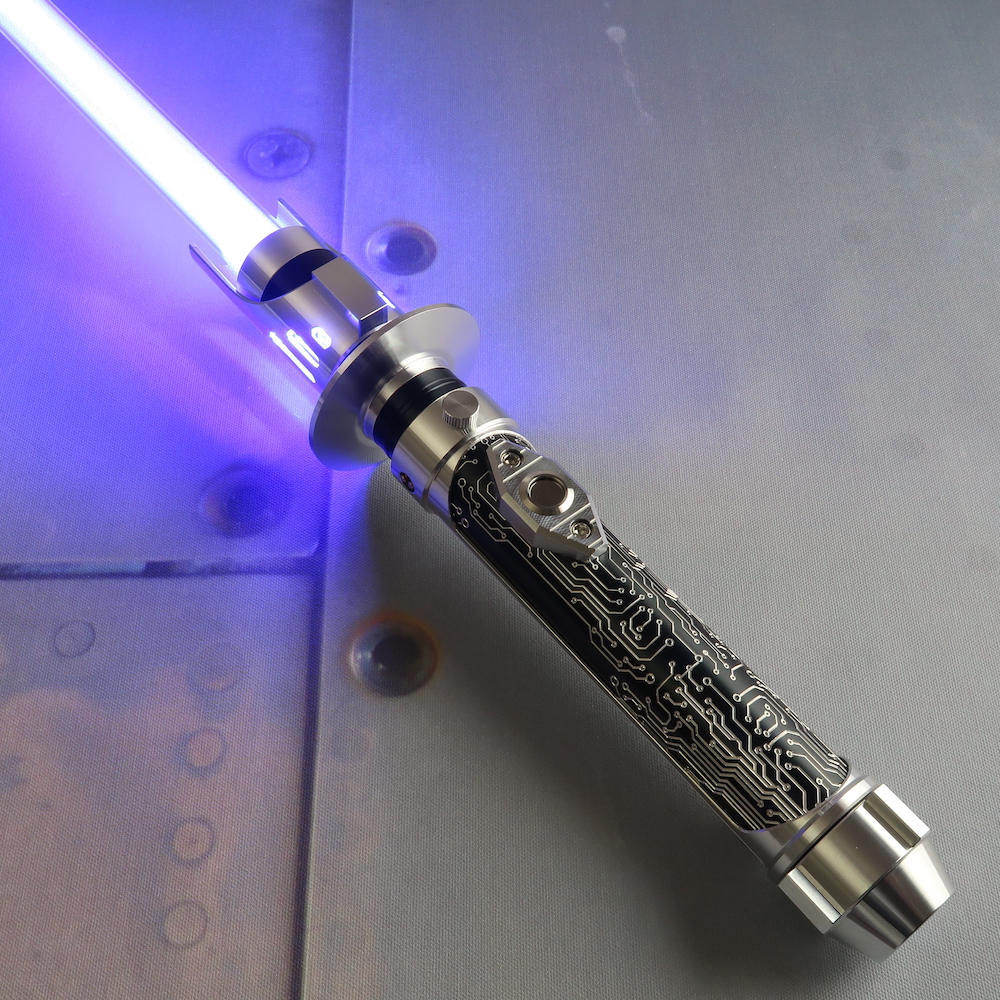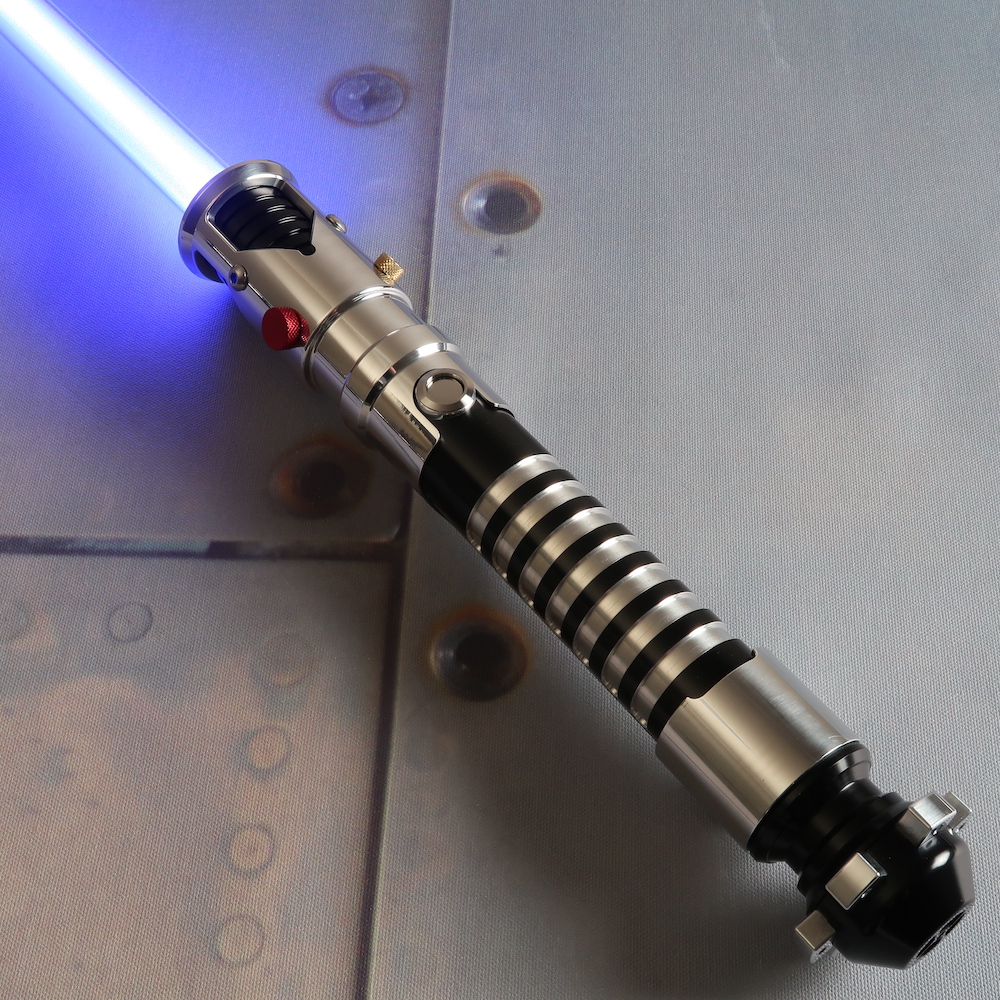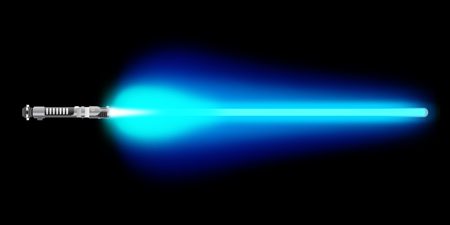Lightsabers
The lightsaber is an iconic weapon in the Star Wars universe that is as beautiful as it is deadly. As the weapon of choice for Jedi and Sith, lightsabers represent the skill, training, and power of their wielders and are often seen in battles between good and evil.

History of the Lightsaber
The origins of the lightsaber traces back to ancient times when early Jedi began experimenting with creating weapons powered by energy. The first prototypes of lightsabers, known as “proto-sabers,” emerged thousands of years before the Republic Era. These early lightsabers were rudimentary compared to the sleek, self-contained weapons we’re familiar with. Proto-sabers were connected to large, external power packs via a cable, limiting the mobility of their wielders and making them cumbersome in combat. Despite these limitations, they represented a significant advancement in weapon technology, combining the energy blade concept with the Force attunement of their users.
As the Jedi Order grew and technology evolved, so did the lightsaber. By the time of the Old Republic, the Jedi had refined the lightsaber’s design, eliminating the need for external power packs. This breakthrough was achieved by miniaturizing the power source into a compact, self-contained unit within the hilt, allowing for greater maneuverability and making lightsabers the handheld weapons associated with the Jedi and Sith. The new design enabled Jedi to serve more effectively as peacekeepers and defenders of the galaxy, engaging in combat more easily.
Lightsaber Evolution Through Different Eras

Old Republic through Fall of the Jedi Eras: During this period, lightsabers were wielded by Jedi as symbols of their role as peacekeepers and defenders of the galaxy. During the Old Republic Era, schisms within the Jedi order led to the creation of the Sith, putting lightsaber wielders on both the light and dark side of the force. They participated in numerous battles and conflicts, most notably the Clone Wars. The refinement of the lightsaber’s design during these eras made it an indispensable tool for the Jedi, representing their commitment to maintaining peace and justice.

Imperial Era: The rise of the Galactic Empire marked a dark time for lightsabers and their wielders. As the Empire hunted and eliminated the Jedi, lightsabers became rare, relics of a bygone era. Sith Lords like Darth Vader and his Inquisitors, however, continued to use them, though with more sinister intent. For the Sith, lightsabers were not just weapons but tools of oppression, used to enforce the Emperor’s will and spread fear throughout the galaxy.

New Republic Era: After the fall of the Empire, lightsabers saw a resurgence with the rise of new Jedi like Luke Skywalker and Rey. These new Jedi sought to rebuild the Order and restore balance to the Force, using lightsabers not only in combat but as symbols of hope and renewal. The evolution of the lightsaber continued, with each new wielder adding their own modifications and personal touches to the ancient weapons.
Components of a Lightsaber
A lightsaber is a finely crafted weapon that combines technology with the mystical energy of the Force. Each component plays a vital role in its function, from the plasma blade to the mechanisms housed within the hilt. Together, these elements create a powerful weapon that reflects the skill and identity of its wielder. Here’s an overview of the key parts that make up a lightsaber:

Blade: The star of any lightsaber is its plasma blade, a concentrated beam of pure energy capable of cutting through almost any material. These blades emit a distinct hum and glow, which varies in color depending on the kyber crystal used.
Kyber crystal: The kyber crystal is the essential core of a lightsaber. These rare and powerful crystals are naturally attuned to the Force, allowing them to focus and amplify the energy needed to generate the blade. Jedi and Sith attune these crystals to their own Force connection, often influencing the blade’s color and characteristics.
Hilt: The hilt of a lightsaber is meticulously crafted from durable metal, designed to house the intricate components that make the weapon function. Each hilt is often customized to suit the preferences and needs of the wielder, making every lightsaber a unique extension of its user’s identity.
Activation Switch: The activation switch is a critical component of the lightsaber, allowing the wielder to activate and deactivate the blade with precision. The placement and design of the switch are typically customized to the user’s preferences, ensuring quick and reliable access during combat.
Power Cell: Housed within the hilt, a diatium power cell is a compact but highly efficient energy source, designed to sustain the blade during prolonged use in battle or training.
Emitter: The emitter is located at the top of the hilt, where the blade emerges. It focuses the energy channeled through the kyber crystal, shaping it into a blade that is both stable and deadly. The design of the emitter can vary, influencing the blade’s length, width, and sometimes built in a way to combat the instability of a fractured kyber crystal, such as the vents on Kylo Ren’s crossguard lightsaber.
Types of Lightsabers
Lightsabers come in various forms, each designed to complement the combat style and preferences of the wielder. These diverse designs reflect the individuality of their users, whether Jedi, Sith, or other Force-sensitive beings.
Single-Bladed Lightsabers
The single-bladed lightsaber is the most common and iconic form, featuring a single blade that extends from the hilt. This design is favored by most Jedi and Sith due to its versatility and simplicity, making it well-suited for a wide range of combat scenarios. Single-bladed lightsabers are often seen as the standard weapon for Force-users, providing a balanced approach to both offense and defense.
Double-Bladed Lightsabers
Also known as a “saberstaff,” the double-bladed lightsaber features blades on both ends of a single hilt. Wielded most famously by the Sith Apprentice Darth Maul, this design is particularly effective for aggressive combat styles, allowing the wielder to perform wide-sweeping attacks and rapid, spinning maneuvers. The double-bladed lightsaber requires a high level of skill to master but offers unparalleled offensive capabilities in the hands of an expert.
Crossguard Lightsabers
Crossguard lightsabers are distinguished by their additional blades that project horizontally from the sides of the hilt, forming a cross-like shape. These side blades, or quillons, provide extra protection for the wielder’s hands during combat, making it more difficult for an opponent to strike the wielder’s hilt or hands. Kylo Ren’s unstable, crackling lightsaber is a well-known example of this design, adding a layer of unpredictability to its use in battle.
Lightsaber Colors and Their Meanings
Lightsabers come in a variety of colors, each with its own significance within the Star Wars universe. The color of a lightsaber blade is typically determined by the kyber crystal that powers it, and different colors often symbolize different aspects of a Jedi or Sith’s personality, alignment, or role within the Force.
Blue Lightsabers
Blue is one of the most common lightsaber colors, often associated with Jedi Guardians. These individuals are typically focused on physical combat and protecting the galaxy from threats. Iconic users of blue lightsabers include Obi-Wan Kenobi and Anakin Skywalker.

Green Lightsabers
Green lightsabers are often wielded by Jedi Consulars, who prioritize wisdom and negotiation over combat. They are deeply connected to the Force and often serve as the Order’s diplomats and scholars. Notable users include Yoda, Qui-Gon Jinn, and Luke Skywalker.

Red Lightsabers
Red lightsabers are synonymous with the Sith and other dark side users. The red color is typically achieved through the process of “bleeding” a kyber crystal, which involves pouring negative emotions into the crystal, corrupting it with the dark side. Darth Vader and Darth Maul are famous wielders of red lightsabers.

Purple Lightsabers
Purple lightsabers are rare and are often associated with Jedi who have a more nuanced understanding of the Force, blending both light and dark side techniques. Mace Windu is the most famous user of a purple lightsaber, symbolizing his unique connection to the Force and his unorthodox fighting style.

White Lightsabers
White lightsabers represent purity and independence, often wielded by those who have walked away from both the Jedi and Sith orders. Ahsoka Tano, who leaves the Jedi Order but continues to fight for good, famously uses white lightsabers.

Yellow Lightsabers
Yellow lightsabers are traditionally associated with the Jedi Temple Guards, representing a balance between combat skills and scholarly pursuits. These lightsabers symbolize vigilance and protection, guarding the temple and upholding justice.

Orange Lightsabers
Orange lightsabers are quite rare and are often associated with users who possess a deep understanding of the Force’s mysteries, typically leaning towards the light side while not strictly adhering to the Jedi code. The color suggests creativity, individuality, and a non-conventional approach to the Force.
Each lightsaber color tells a story about its wielder, providing insight into their connection with the Force and their role within the galaxy. Whether a blade is blue, green, red, or any other hue, it serves as a powerful symbol of the user’s journey and philosophy.

Lightsaber Combat and Usage
Lightsaber combat is a refined and intricate art that has evolved over thousands of years, with various forms developed to suit different combat scenarios and individual fighting styles. Each lightsaber combat form is a distinct approach to lightsaber combat, emphasizing different aspects such as defense, offense, agility, and power. Mastery of these seven forms is essential for Jedi and Sith alike, as they define how a lightsaber is used in battle.

Form I: Shii-Cho is the most basic and fundamental lightsaber form, often taught to beginners. It focuses on simple, broad movements and disarming opponents rather than inflicting harm. This form is versatile and can be adapted to multiple combat situations, making it a foundation upon which other, more advanced forms are built.
Form II: Makashi is a more elegant and precise style, specifically designed for saber-to-saber combat. It is characterized by its focus on balance, footwork, and controlled, efficient strikes. Practitioners of Makashi prioritize finesse and accuracy over brute strength, making it ideal for dueling other lightsaber wielders.
Form III: Soresu is a defensive form that emphasizes protection and survival. It was developed as a response to the widespread use of blasters, allowing Jedi to effectively deflect and redirect blaster bolts. Soresu practitioners are known for their patience and resilience, often outlasting opponents by conserving energy and minimizing openings for attack.
Form IV: Ataru is an aggressive and acrobatic form, relying on speed, agility, and dynamic movement. It incorporates flips, spins, and other physical maneuvers to overwhelm opponents with a flurry of attacks. Ataru is especially effective in open spaces where the practitioner can take full advantage of their mobility, but it can be exhausting to maintain for long periods.
Form V: Shien/Djem So combines power and strength with a focus on counterattacks. Shien is particularly effective against blaster-wielding opponents, allowing the practitioner to deflect shots back at their source. Djem So, the more aggressive variant, is designed for lightsaber combat, emphasizing powerful, crushing strikes that can break through an opponent’s defenses.
Form VI: Niman is a balanced and adaptable form that blends elements from multiple other forms. It is often considered a jack-of-all-trades style, allowing the practitioner to be moderately skilled in a variety of techniques without specializing in any one area. Niman also integrates Force abilities into combat, making it a versatile option for Jedi who want to combine their lightsaber skills with their Force powers.
Form VII: Juyo/Vaapad is the most ferocious and unpredictable of the lightsaber forms, requiring complete mastery and a deep connection to the Force. Juyo is characterized by its aggressive, relentless attacks, often pushing the practitioner to the limits of their emotional and physical endurance. Vaapad, a variant developed by Jedi Master Mace Windu, allows the user to channel and control their inner darkness without succumbing to it, making it a dangerous form to wield but incredibly powerful in the right hands.
In terms of offensive applications, lightsabers are unparalleled in their ability to cut through almost any material. Whether slicing through doors, droids, or even vehicles, the blade can make quick work of most obstacles.
Defensively, lightsabers are just as effective. Skilled wielders can deflect and even redirect blaster bolts with incredible precision, turning the enemy’s firepower back against them. Advanced practitioners can also use their lightsabers to absorb and neutralize Force lightning, a powerful and dangerous technique often employed by Sith. This defensive capability is a testament to the lightsaber’s versatility, making it both a shield and a sword in the hands of a master.
The Rite of Passage: Constructing a Lightsaber
Constructing a lightsaber is a pivotal rite of passage for a Jedi, symbolizing the transition from Padawan to a full-fledged Jedi Knight. This process, known as “The Gathering,” is not merely about creating a weapon but also about forging a deep connection with the Force. The construction of a lightsaber underscores a Jedi’s commitment to peace, justice, and the protection of the galaxy.
The Search for a Kyber Crystal
The journey begins with a quest to find a kyber crystal, the essential core of a lightsaber. These rare crystals are naturally attuned to the Force and are unique to each Jedi. The most famous location for this search is the Crystal Caves on Ilum, where young Jedi must face trials that test their resolve and connection to the Force. The crystal, in a sense, chooses its Jedi, creating a bond that is central to the lightsaber’s power.
Assembling the Lightsaber
Once the kyber crystal is found, the Padawan assembles the lightsaber. This process requires deep concentration and a strong connection to the Force. The hilt, often customized to reflect the Jedi’s personality and combat style, is crafted from durable materials. Using the Force, the Jedi aligns the crystal with the power cell, focusing lens, and emitter matrix, ensuring the weapon functions perfectly. This act of creation is both a practical task and a spiritual journey, symbolizing the Jedi’s mastery of their training.
Symbolism of the Lightsaber
For the Jedi, the lightsaber represents their role as guardians of peace and justice. It is a symbol of hope, light, and the Jedi’s commitment to protect and defend. The Sith, on the other hand, view lightsabers as symbols of power, fear, and dominance. The red blades of Sith lightsabers, created by corrupting a kyber crystal with the dark side, reflect their allegiance to the dark side and their ruthless pursuit of power.
Practical Uses and Ceremonial Roles
Beyond combat, lightsabers serve practical purposes, such as providing light in dark environments or cutting through obstacles during missions. They also play a significant role in Jedi ceremonies, particularly the knighting ceremony. During this ritual, the lightsaber is used to ceremonially sever the Padawan’s training braid, marking their advancement to Jedi Knight. This act symbolizes the completion of their journey and their readiness to take on the responsibilities of a Jedi.




